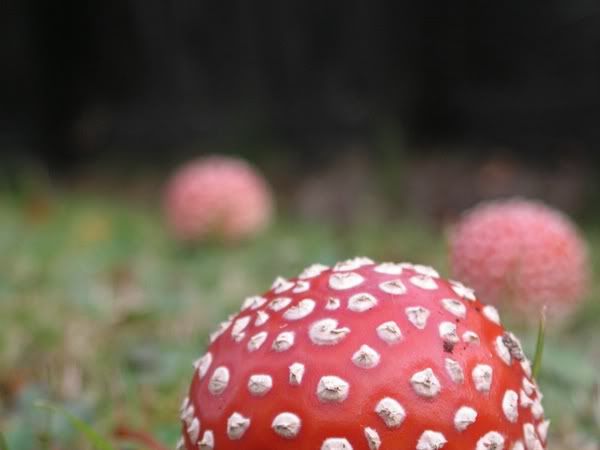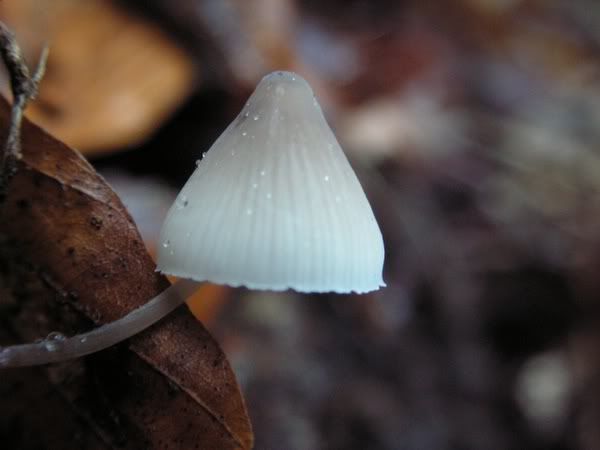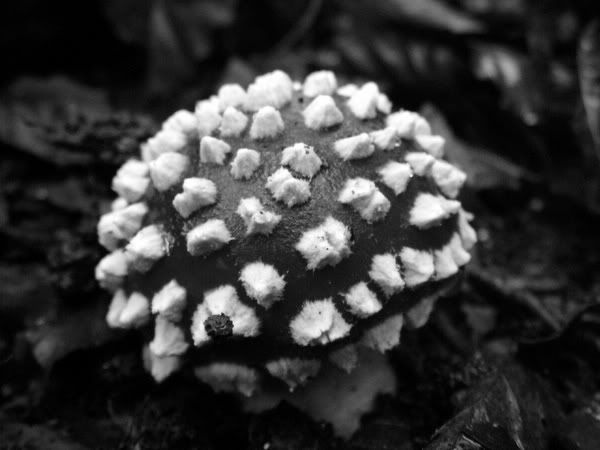Friday, June 23, 2006
A glimpse of life underground
There has been a real glut of great nature writing and photography in blogs over the last couple of weeks. Seeing the great posts that people like Bev and Wayne have put together has made me in equal parts jealous of those enjoying an insectfull spring/summer and motivated to get out and record a little of the natural world around me. Spurred by the great posts I've read I have been able to get a few pics I am quite fond of so expect a few picture-laden posts in the next little while starting right now with a look at the other, other kingdom: The Fungi

The above picture isn't just my tribute to a famous internet meme - it's also the only sign I can notice of a vast community sprawling under my front lawn. Mushrooms and toadstools like the ones above are the visible protuberances of larger organisms - the tip of fungal icebergs. Most of the growth of these organisms comes in thin threads of cells called hyphae which extend through the soil - Stephen Jay Gould wrote of one such organism that covered some 30 acres in an essay entitled A Humungous Fungus Among Us.A mushroom usually happens when hyphae from two different organisms meet and fuse, fused hyphae will eventually(maybe decades after their fusion) go on to produce a spores and a fruiting body (the actual mushroom) as a means of dispersing them.

Apart from being really cool fungi have a massive ecological importance. Fungi are often the first forms of live to invade dead logs on the forest floor. It's this action that allows the formation of the 'saproxylic community" - micro-invertebrates like springtails and mites eat the fungi which starts to free up the resources locked in the logs for organisms like earthworms. At the same time the whole saproxylic community that forms make great meals for snails and Peripatus and all the charismatic megafauna people are so keen on preserving. Still, fungi play an ecological role that is even more important than invading fallen logs. Most plants have colonies of 'mycorrhizal' fungi that live on their roots. These fungi live in very tight symbiotic relationships in which the plants are very dependant on the fungi for various nutrients they can't take from the soil while fungi rely on the plants for sugars derived from photosynthesis. Mycorrhizal fungi are thought to be a key factors determining the ability of plants to colonise new areas.
By basing this little discussion on the photos I've taken I have focused on those few fungi that actually go in for such elaborate means of dispersing themselves as fruiting bodies. In fact the few mushrooms that you do see from time to time aren't simply the tip of subterranean icebergs - they are the tip of a very small percentage of a very great number of fungi living in the soil. Most fungi reproduce by fission (like yeasts) or budding off at their hyphae. Still, there is something a little special about those few that allow us a peak into the lives they lead underground so here is one last photo:

3 Comments:
cara mengobati bibir kering dan pecah |
agen pusat walatra kapsul |
PUSAT HERBAL TASIKMALAYA |
obat busung air ascites |
cara mengatasi penyakit epilepsi |












